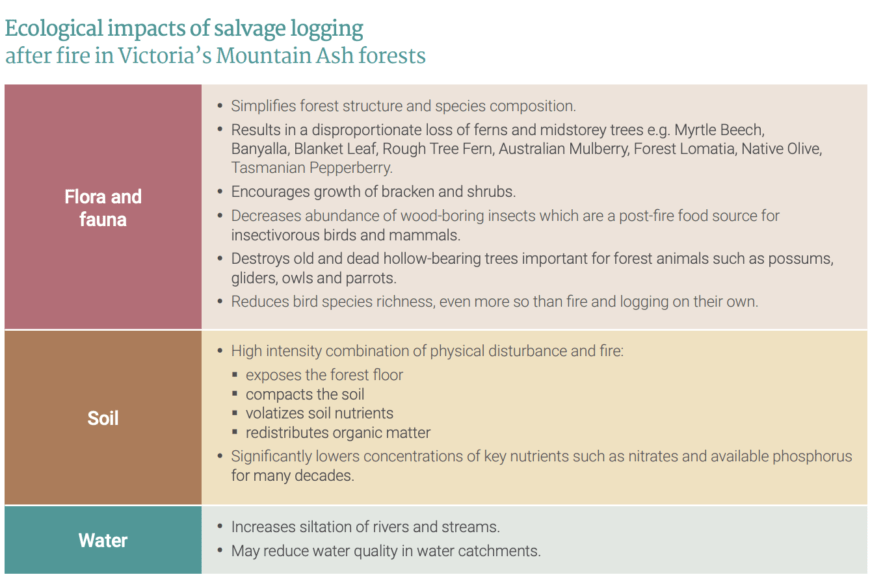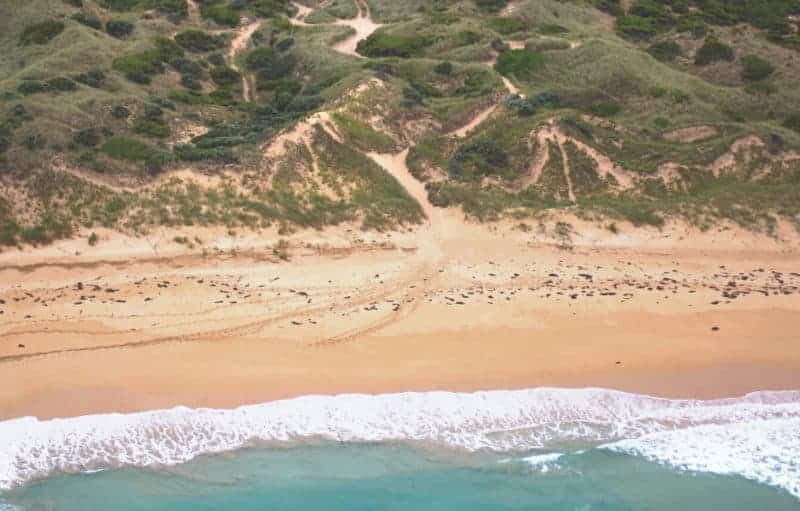PARK WATCH March 2020 |
Short-term economic gain, long-term ecological damage – VNPA Nature Conservation Campaigner John Kotsiaris denounces salvage logging.
Victoria is already Australia’s most cleared state. Now over 1.4 million hectares have burnt in this tragic fire season. And this comes in addition to planned fire increasing significantly in recent years, with around 740,000 hectares across our state treated in the last five years alone.
Due to so much recent fire in the landscape, there are very limited areas of mature and old-growth forests remaining. Vast areas of our temperate forests are being homogenised into young post-fire regrowth; regrowth which is often more flammable than older forests.
In the highly impacted Gippsland region where rainforests and other areas with no recorded fire history have now been burned, patches of unburnt and partially burnt vegetation both within and outside the boundaries of the fires must be protected. These are now vital areas of high conservation value serving as both refuge areas for wildlife and beacons of biodiversity recovery.
An urgent threat to the post-fire recovery of Victoria’s forests is that of salvage logging – a damaging practice historically pushed by logging industries in an effort to reduce economic impacts and/or take financial advantage of wildfire and other natural disasters.
Salvage logging harvests burnt trees. It subjects native forests to the mechanical pressures of logging during the post-fire recovery stage of the vegetation, compounding various disturbance pressures of both fire and logging. Added claims that salvage logging assists with fuel reduction are contrary to studies which show that it can actually increase bushfire risk, because the salvage logging slash increases fine surface fuels on the ground.
Trees wanted dead or alive
The Victorian Government estimates that in East Gippsland at least 50 per cent of the trees in logging coupes on the current Timber Release Plan have been impacted by the recent bushfires. Despite the now extra importance of any unburnt and partially burnt vegetation in the region, the native forest logging industry is continuing its push for logging and salvage logging. There is also “salvage-like” logging happening along roads and fire tracks with reports that sawmills are expecting to share 15,000 tonnes of timber from trees felled in the operation to re-open the Princes Highway and other regional roads.
The Institute of Foresters of Australia, while acknowledging the negative ecological impacts of salvage logging, is pushing for the salvaging of timber from fire affected trees within logging coupes. Others go one step further, with East Gippsland sawmills, the Australian Forest Products Association and some politicians calling for governments to support salvaging timber from all burnt forests and across all impacted land tenures, including within nature reserves and national parks.
However, salvage logging and associated mechanical disturbances to vegetation significantly affects the natural post-fire recovery processes of forests. It’s inconsistent with the management objectives of protected areas.
After a fire, both living and dead trees serve critical ecological functions within a recovering forest ecosystem. Most of Victoria’s eucalypts are excellent resprouters and can fairly rapidly re-establish an extensive elevated leaf area after medium and even high-intensity fires. This simultaneously shades lower recovering vegetation, including other resprouting plants and seedlings. However, a few eucalypts are relatively poor resprouters and are easily killed by large fire. Victoria’s much-logged Mountain Ash and Alpine Ash trees typically regenerate from seed after high severity fires.
Dead trees, both standing and fallen, provide important habitat for wildlife (e.g. hollows), contribute significant organic matter to the soil, and promote wood-boring insects which are a post-fire food source for other animals. Clusters of burned fallen trees also protect young regenerating seedlings from browsing by herbivores.
Salvage logging can also undermine efforts to protect any small remaining areas of mature trees within the burn area. This “island retention” is crucial in the aftermath of a broadscale natural disaster like we are currently experiencing in Victoria. Patches of unburned green trees, and patches with green trees intermixed with dead trees, need urgent protection and careful management.
Salvage logging can further increase fire risk at a time when frequent fire is at the forefront of land management challenges.
Fire suppression, ignition control, and retaining older growth forests are all paramount in curtailing the collapse of Australia’s temperate forests and avoiding their transition into more fire-prone vegetation types.
Salvage logging only adds extra pressure to forests already under threat from frequent wildfire, inappropriate planned burning regimes, and a warming climate.
Did you like reading this article? Want to be kept up to date about this and other nature issues in Victoria? Subscribe to our email updates.
You can also receive our print magazine Park Watch four times a year by becoming a member. Find out more here.

